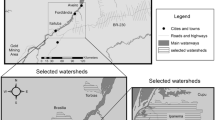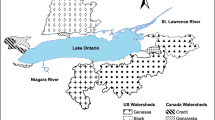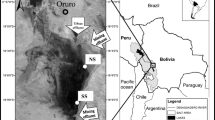Abstract
Studies worldwide have shown that mercury (Hg) is a ubiquitouscontaminant, reaching even the most remote environments such ashigh-altitude lakes via atmospheric pathways. However, very fewstudies have been conducted to assess Hg contamination levels ofthese systems. We sampled 90 mid-latitude, high-altitude lakes from seven national parks in the western United States during afour-week period in September 1999. In addition to the synoptic survey, routine monitoring and experimental studies were conducted at one of the lakes (Mills Lake) to quantify MeHg fluxrates and important process rates such as photo-demethylation. Results show that overall, high-altitude lakes have low total mercury (HgT) and methylmercury (MeHg) levels (1.07 and 0.05 ng L-1, respectively), but a very good correlation of Hg to MeHg (r2= 0.82) suggests inorganic Hg(II) loading is a primary controlling factor of MeHg levels in dilute mountain lakes. Positive correlations were also observed for dissolved organic carbon (DOC) and both Hg and MeHg, although to a much lesser degree. Levels of MeHg were similar among the seven national parks, with the exception of Glacier National Park where lowerconcentrations were observed (0.02 ng L-1), and appear to berelated to naturally elevated pH values there. Measured rates ofMeHg photo-degradation at Mills Lake were quite fast, and thisprocess was of equal importance to sedimentation and stream flowfor removing MeHg. Enhanced rates of photo-demethylation are likely an important reason why high-altitude lakes, with typically high water clarity and sunlight exposure, are low in MeHg.
Similar content being viewed by others
References
Amyot, M., Mierle, G., Lean, D. R. S. and McQueen, D. J.: 1994, 'Sunlight-induced formation of dissolved gaseous mercury in lake waters', Environ. Sci. Technol. 28, 2366–2371.
Benoit, J. M., Hurley, J. P., Babiarz, C. L., Andren, A. W. and Krabbenhoft, D. P.: 1994, 'A Mass Balance Study of Mercury for Pallette Lake, Wisconsin (Abstract), Mercury As a Global Pollutant, Toward Integration and Synthesis', Proceedings of the 3rd International Meeting, Whistler, B.C., 4–8 August, 1994.
Benoit, J. M., Gilmour, C. C., Mason, R. P. and Heyes, A.: 1999, 'Sulfide controls on mercury speciation and bioavailability to methylating bacteria in sediment and pore waters', Environ. Sci. Technol. 33, 951–957.
Bloom, N. S.: 1992, 'On the methylmercury content of fish', Can. J. Fish. Aquat. Sci. 49, 1131–1140.
Bloom, N. S. and Fitzgerald, W. F.: 1988, 'Determination of volatile mercury species at the picogram level by low temperature gas chromatography with cold-vapor atomic fluorescence detection', Anal. Chim. Acta. 208, 151–161.
Bodaly, R. A., Hecky, R. E. and Fudge, R. J. P.: 1984, 'Increases in fish mercury levels in lakes flooded by the Churchill River diversion, Northern Manitoba', Can. J. Fish. Aquat. Sci. 41, 682–691.
Clow, D. W., Striegl, R., Nanus, L., Mast, M. A., Campbell, D. H. and Krabbenhoft, D. P.: 2002, 'Chemistry of selected high-elevation lakes in seven national parks in the western United States', Water, Air, and Soil Pollut.: Focus 2, 139–164.
Engstrom, D. R. and Swain, E. B.: 1997, 'Recent declines in atmospheric mercury deposition in the upper midwest, Environ. Sci. Technol. 31, 960–967.
Fitzgerald, W. F.: 1995, 'Is mercury increasing in the atmosphere? The need for an atmospheric mercury network (AMNET)', Water, Air, and Soil Pollut. 80, 245–254.
Fitzgerald, W. F. and Watras, C. J.: 1989, 'Mercury in surficial waters rural Wisconsin lakes', Sci. Total Environ. 87/88, 223–232.
Gilmour, C. C., Henry, E. A. and Mitchell, R.: 1991, 'Sulfate stimulation of mercury methylation in freshwater sediments', Environ. Sci. Technol. 26, 281–2287.
Gilmour, C. C., Riedel, G. S., Ederlington, M. C., Bell, J. T., Benoit, J. M., Gill, G. A. and Stordal, M. C.: 1998, 'Methylmercury concentrations and production rates across a trophic gradient in the Northern Everglades', Biogeochemistry 40, 326–346.
Gill, G. A. and Fitzgerald, W. F.: 1987, 'Picomolar mercury measurements in seawater and other materials using stannous chloride reduction and two-stage gold amalgamation with gas phase detection', Marine Chem. 20, 227–243.
Heinz, G. H. and Hoffman, D. J.: 1998, 'Methylmercury chloride and selenomethionine interactions on health and reproduction in Mallards', Environ. Toxic. Chem. 17, 139–145.
Horvat, M., Bloom, N. S. and Liang, L.: 1993, 'Comparison of distillation with other current isolation methods for the determination of MeHg compounds in low level environmental samples. Part I. Sediment', Anal. Chim. Acta 282, 135–152.
Hurley, J. P., Benoit, J. M., Babiarz, C. L., Shafer, M. M., Andren, A. W., Sulivan, J. R., Hammond, R. and Webb, D.: 1995, 'Influences of watershed characteristics on mercury levels in Wisconsin rivers', Environ. Sci. Technol. 29, 1867–1875.
Kelly, C. A., Rudd, J. W. M., Bodaly, R. A., Roulet, N. P., St. Louis, V. L., Heyes, A., Moore, R. R., Schiff, S., Aravena, R., Scott, K. J., Dyck, B., Harris, R., Warner, B. and Edwards, G.: 1997, 'Increases in fluxes of greenhouse gases and methyl mercury following flooding of an experimental reservoir', Environ. Sci. Technol. 31, 1334–1344.
Krabbenhoft, D. P., Beniot, J. M. Babiarz, C. L., Hurley, J. P. and Andren, A. W.: 1995, 'Mercury cycling in the Allequash Creek watershed, northern Wisconsin', Water, Air, and Soil Pollut. 80, 425–433.
Krabbenhoft, J. P. Hurley, M. L. Olson, and Cleckner, L. B.: 1998a, 'Diurnal variability of mercury phase and species distributions in the Florida Everglades', Biogeochemistry 40, 311–325.
Krabbenhoft, D. P., Gilmour, C. C. Beniot, J. M. Babiarz, C. L. Andren, A. W. and Hurley, J. P.: 1998b, 'Methylmercury dynamics in littoral sediments of a temperate seepage lake', Can. J. Fish. Aquat. Sci. 55, 835–844.
Krabbenhoft, D. P., Wiener, J. G., Brumbaugh, W. G., Olson, M. L., DeWild, J. F. and Sabin, T. J.: 1999, 'A National Pilot Study of Mercury Contamination of Aquatic Ecosystems along Multiple Gradients', in D. W. Morganwalp and H. T. Buxton, (eds), U.S. Geological Survey Toxic Substances Hydrology Program — Proceedings of the Technical Meeting, Charleston, South Carolina, 8–12 March 1999, Vol. 2 of 3, Contamination of Hydrologic Systems and Related Ecosystems: U.S. Geological Survey Water-Resources Investigations Report 99-4018B, pp. 147–160.
Laurion, I., Ventura, M., Catalan, J., Psenner, R. and Sommaruga, R.: 2000, 'Attenuation of ultra-violet radiation in mountain lakes: Factors controlling the among-and within-lake variability', Limnol. and Oceanogr. 45(6), 1274–1288.
Morris, D. P., Zagarese, H., Williamson, C. E., Balseiro, E. G., Hargreaves, B. R., Modenutti, B., Moeller, R. and Queimalinos, C.: 1995, 'The attenuation of solar UV radiation in lakes and the role dissolved organic carbon', Limnol. and Oceanogr. 40(8), 1381–1391.
Olson, M. L., Cleckner, L. B. Hurley, J. P. Krabbenhoft, D. P. and Heelan, T. W.: 1997, 'Resolution of matrix effects on analysis of total and methyl mercury in aqueous samples from the Florida Everglades', Fresenius J. Anal. Chem. 358, 392–396.
Olson, M. L. and DeWild, J. F.: 1999, 'Low-level Techniques for the Collection and Species-specific Analysis of Low Levels of Mercury in Water, Sediment and Biota', in D. W. Morganwalp and H. T. Buxton (eds), U.S. Geological Survey Toxic Substances Hydrology Program — Proceedings of the Technical Meeting, Charleston, South Carolina, 8–12 March 1999, Vol. 2 of 3, Contamination of Hydrologic Systems and Related Ecosystems: U.S. Geological Survey Water-Resources Investigations Report 99-4018B, pp. 191–200.
Patterson, C. C. and Settle, D. M.: 1976, 'The Reduction of Orders of Magnitude Errors in Lead Analyses of Biological Materials and Natural Waters by Evaluating and Controlling the Extent and Sources of Industrial Lead Contamination Introduced during Sample Collection, Handling and Analysis', in P. D. LaFleur (ed.), Accuracy in Trace Analysis: Sampling, Sample Handling, and Analysis U.S. National Bureau of Standards Special Publication 422, pp. 321–351.
Scheuhammer, A. M.: 1991, 'Effects of acidification on the availability of toxic metals and calcium to wild birds and mammals', Environ. Pollut. 71, 329–375.
Sellers, P., Kelly, C. A., Rudd, J. W. M. and MacHutchon, A. R.: 1996, 'Photodegradation of methylmercury in lakes', Nature 380, 694–697.
St. Louis, V. L., Rudd, J. W. M., Kelly, C. A., Beaty, K. G., Bloom, N. S. and Flett, R. J.: 1994, 'Importance of wetlands as sources of methyl mercury to boreal forest ecosystems', Can. J. Fish. Aquat. Sci. 51, 1065–1076.
Swain, E. B., Engstrom, D. R., Brigham, M. F., Henning, T. A. and Brezonik, P. L.: 1992, 'Increasing rates of atmospheric mercury deposition in the midcontinental North America', Science, (Washington, DC) 257, 784–787.
U.S. Environmental Protection Agency: 2001, Update: Listing of Fish and Wildlife Advisories. LFWA Fact Sheet EPA-823-F-01-010, Office of Water, Washington, DC, 9 pp.
United States Environmental Protection Agency (USEPA): 1997, Mercury Study Report to Congress, United States Environmental Protection Agency, EPA-452-97-003-010, Office of Air and Radiation, 1980 pp.
Van Metre, P. C., Callender, E. and Fuller, C. C.: 1998, 'Similar rates of decrease of persistent, hydrophobic and particle-reactive contaminants in riverine systems', Environ. Sci. Technol. 32, 3312–3317.
Watras, C. J., Bloom, N. S., Hudson, R. J. M., Gherini, S., Munson, R., Claas, S., Morrison, K., Hurley, J.P., Wiener, J. G., Fitzgerald, W. F., Mason, R., Vandal, G., Powel, D., Rada, R., Rislov, L., Winfey, M., Krabbenhoft, D. P., Andren, A. W., Babiarz, C., Porcella, D. B. and Huckabee, J.: 1994, 'Sources and Fates of Mercury and Methylmercury in Wisconsin Lakes', in Watras and Huckabee (eds), Mercury as a Global Pollutant: Integration and Synthesis, Lewis Pub., Chelsea, MI, pp. 153–177.
Watras, C. J., Morrison, K. A., Host, K. and Bloom, N. S.: 1995a, 'Concentration of mercury species in relationship to other site-specific factors in the surface waters of northern Wisconsin lakes', Limnol. and Oceanogr. 40, 556–565.
Watras, C. J., Morrison, K. A. and Bloom, N. S.: 1995b, 'Mercury in remote Rocky Mountain lakes of Glacier National Park, Montana, in comparison with other temperate North American regions, Can. J. Fish. Aquat. Sci. 52, 1220–1228.
Author information
Authors and Affiliations
Corresponding author
Rights and permissions
About this article
Cite this article
Krabbenhoft, D.P., Olson, M.L., Dewild, J.F. et al. Mercury Loading and Methylmercury Production and Cycling in High-Altitude Lakes from the Western United States. Water, Air, & Soil Pollution: Focus 2, 233–249 (2002). https://doi.org/10.1023/A:1020162811104
Issue Date:
DOI: https://doi.org/10.1023/A:1020162811104




